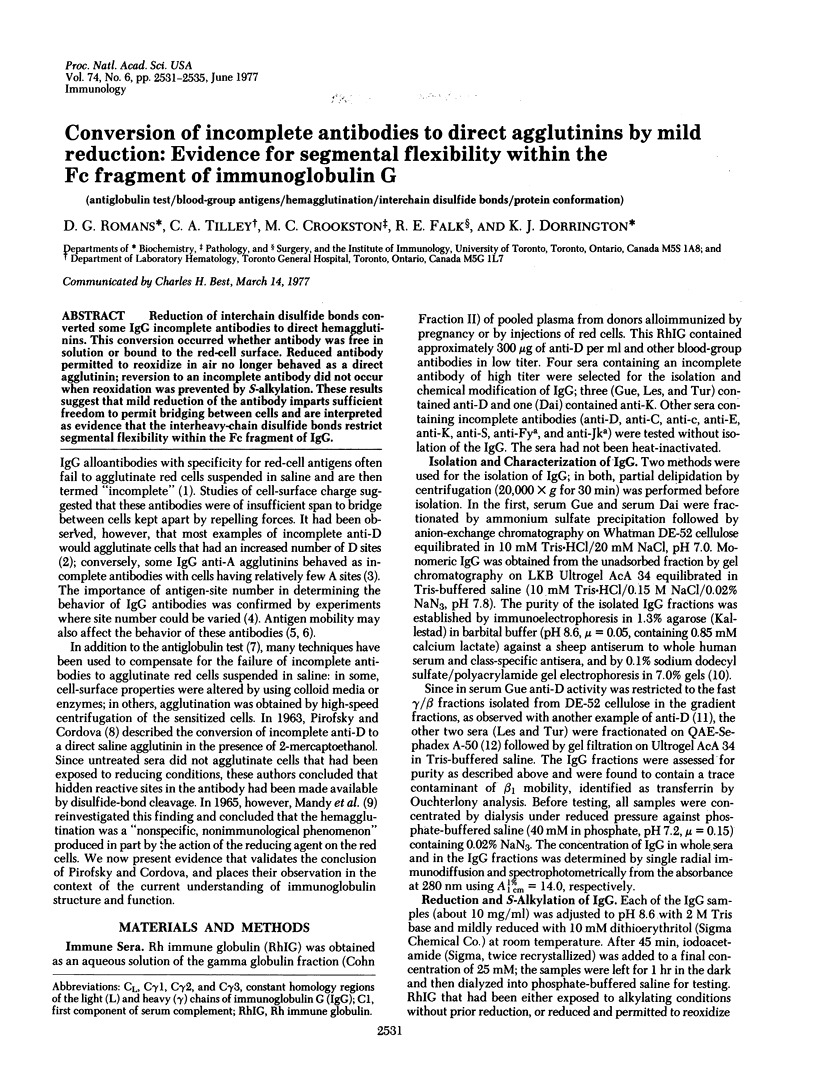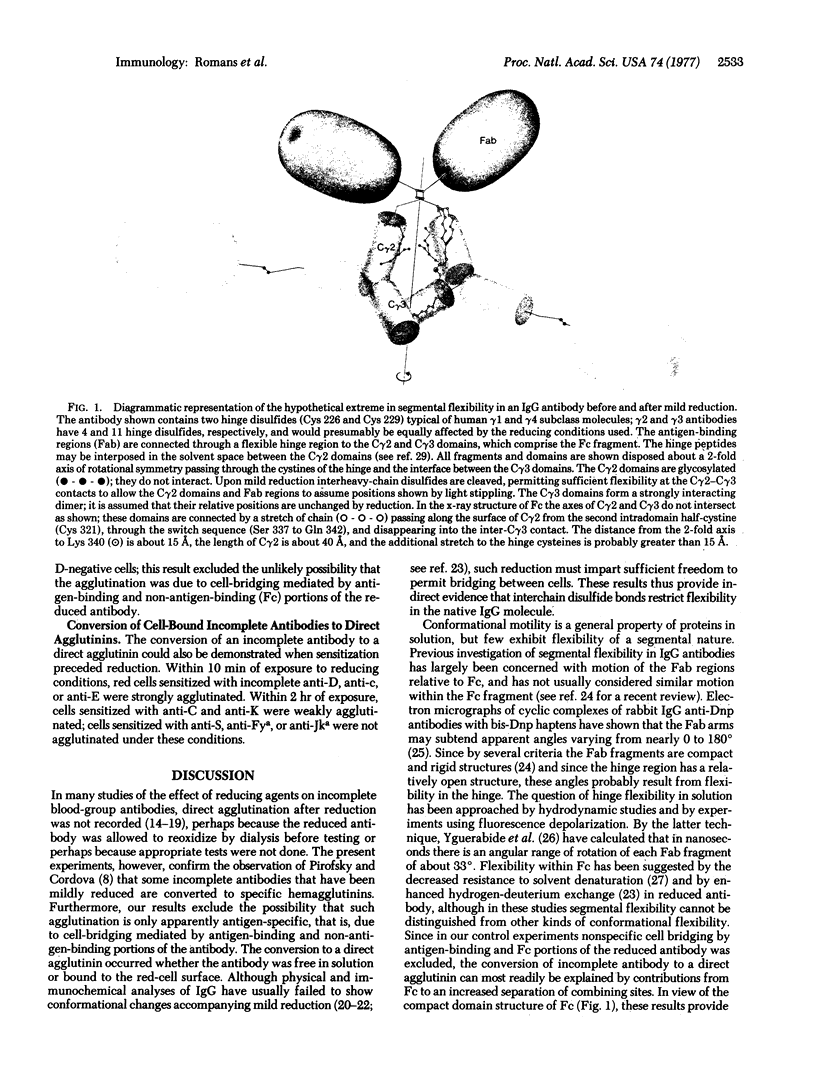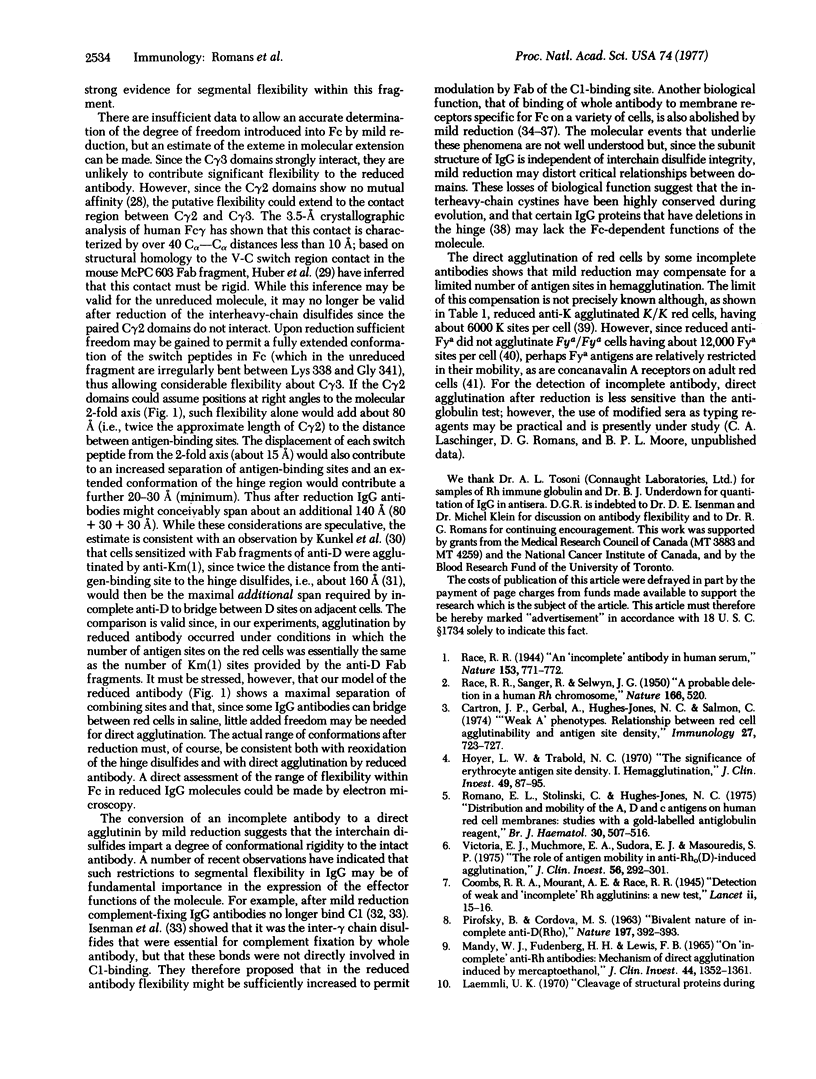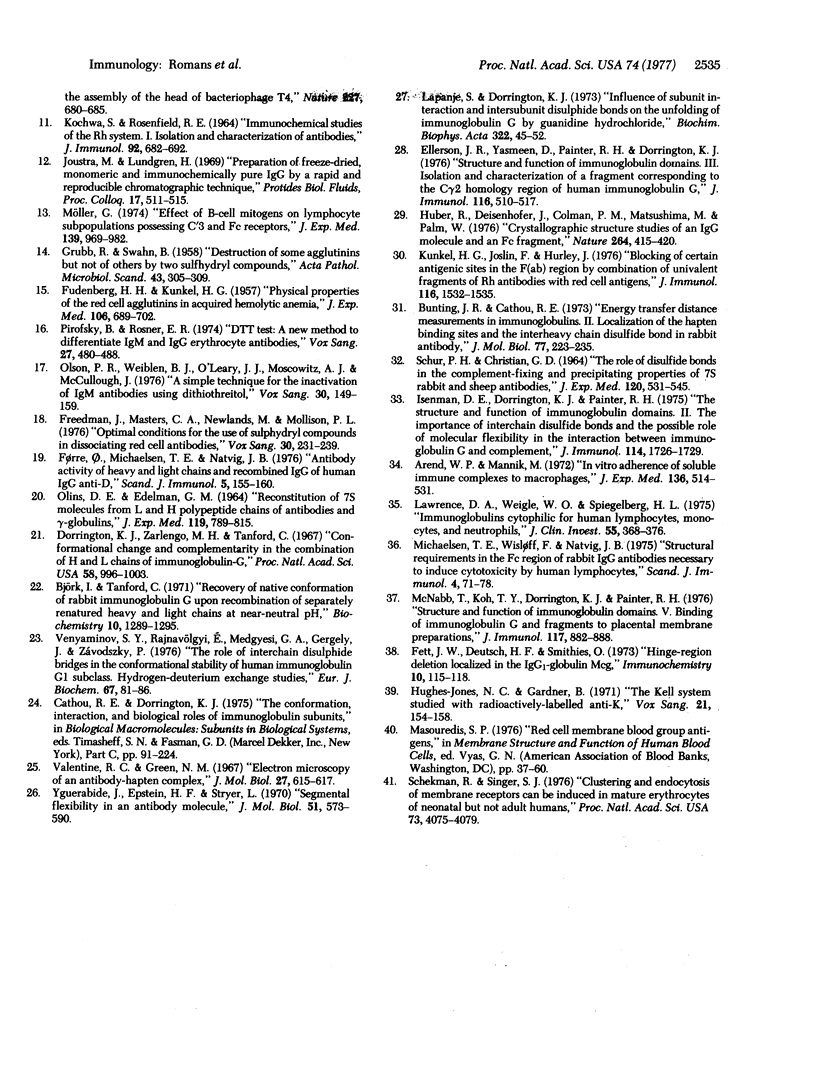Abstract
Reduction of interchain disulfide bonds converted some IgG incomplete antibodies to direct hemagglutinins. This conversion occurred whether antibody was free in solution or bound to the red-cell surface. Reduced antibody permitted to reoxidize in air no longer behaved as a direct agglutinin; reversion to an incomplete antibody did not occur when reoxidation was prevented by S-alkylation. These results suggest that mild reduction of the antibody imparts sufficient freedom to permit bridging between cells and are interpreted as evidence that the interheavy-chain disulfide bonds restrict segmental flexibility within the Fc fragment of IgG.
Full text
PDF




Images in this article
Selected References
These references are in PubMed. This may not be the complete list of references from this article.
- Arend W. P., Mannik M. In vitro adherence of soluble immune complexes to macrophages. J Exp Med. 1972 Sep 1;136(3):514–531. doi: 10.1084/jem.136.3.514. [DOI] [PMC free article] [PubMed] [Google Scholar]
- Björk I., Tanford C. Recovery of native conformation of rabbit immunoglobulin G upon recombination of separately renatured heavy and light chains at near-neutral pH. Biochemistry. 1971 Apr 13;10(8):1289–1295. doi: 10.1021/bi00784a003. [DOI] [PubMed] [Google Scholar]
- Bunting J. R., Cathou R. E. Energy transfer distance measurements in immunoglobulins. II. Localization of the hapten binding sites and the interheavy chain disulfide bond in rabbit antibody. J Mol Biol. 1973 Jun 25;77(2):223–235. doi: 10.1016/0022-2836(73)90333-1. [DOI] [PubMed] [Google Scholar]
- COOMBS R. R. A., STOKER M. G. P. Detection of Q fever antibodies by the anti-globulin sensitization test. Lancet. 1951 Jul 7;2(6671):15–17. doi: 10.1016/s0140-6736(51)93452-6. [DOI] [PubMed] [Google Scholar]
- Cartron J. P., Gerbal A., Hughes-Jones N. C., Salmon C. 'Weak A' phenotypes. Relationship between red cell agglutinability and antigen site density. Immunology. 1974 Oct;27(4):723–727. [PMC free article] [PubMed] [Google Scholar]
- Dorrington K. J., Zarlengo M. H., Tanford C. Conformational change and complementarity in the combination of H and L chains of immunoglobulin-G. Proc Natl Acad Sci U S A. 1967 Sep;58(3):996–1003. doi: 10.1073/pnas.58.3.996. [DOI] [PMC free article] [PubMed] [Google Scholar]
- Ellerson J. R., Yasmeen D., Painter R. H., Dorrington K. J. Structure and function of immunoglobulin domains. III. Isolation and characterization of a fragment corresponding to the Cgamma2 homology region of human immunoglobin G1. J Immunol. 1976 Feb;116(2):510–517. [PubMed] [Google Scholar]
- FUDENBERG H. H., KUNKEL H. G. Physical properties of the red cell agglutinins in acquired hemolytic anemia. J Exp Med. 1957 Nov 1;106(5):689–702. doi: 10.1084/jem.106.5.689. [DOI] [PMC free article] [PubMed] [Google Scholar]
- Fett J. W., Deutsch H. F., Smithies O. Hinge-region deletion localized in the IgG-globulin Mcg. Immunochemistry. 1973 Feb;10(2):115–118. doi: 10.1016/0019-2791(73)90238-3. [DOI] [PubMed] [Google Scholar]
- Forre O., Michaelesen T. E., Natvig J. B. Antibody activity of heavy and light chains and recombined IgG of human IgG anti-D. Scand J Immunol. 1976;5(1-2):155–160. doi: 10.1111/j.1365-3083.1976.tb03002.x. [DOI] [PubMed] [Google Scholar]
- Freedman J., Masters C. A., Newlands M., Mollison P. L. Optimal conditions for the use of sulphydryl compounds in dissociating red cell antibodies. Vox Sang. 1976;30(3):231–239. doi: 10.1111/j.1423-0410.1976.tb02821.x. [DOI] [PubMed] [Google Scholar]
- GRUBB R., SWAHN B. Destruction of some agglutinins but not of others by two sulfhydryl compounds. Acta Pathol Microbiol Scand. 1958;43(3):305–309. doi: 10.1111/j.1699-0463.1958.tb04899.x. [DOI] [PubMed] [Google Scholar]
- Hoyer L. W., Trabold N. C. The significance of erythrocyte antigen site density. I. Hemagglutination. J Clin Invest. 1970 Jan;49(1):87–95. doi: 10.1172/JCI106226. [DOI] [PMC free article] [PubMed] [Google Scholar]
- Huber R., Deisenhofer J., Colman P. M., Matsushima M., Palm W. Crystallographic structure studies of an IgG molecule and an Fc fragment. Nature. 1976 Dec 2;264(5585):415–420. doi: 10.1038/264415a0. [DOI] [PubMed] [Google Scholar]
- Hughes-Jones N. C., Gardner B. The Kell system studied with radioactively-labelled anti-K. Vox Sang. 1971 Aug;21(2):154–158. doi: 10.1111/j.1423-0410.1971.tb00572.x. [DOI] [PubMed] [Google Scholar]
- Isenman D. E., Dorrington K. J., Painter R. H. The structure and function of immunoglobulin domains. II. The importance of interchain disulfide bonds and the possible role of molecular flexibility in the interaction between immunoglobulin G and complement. J Immunol. 1975 Jun;114(6):1726–1729. [PubMed] [Google Scholar]
- KOCHWA S., ROSENFIELD R. E. IMMUNOCHEMICAL STUDIES OF THE RH SYSTEM. I. ISOLATION AND CHARACTERIZATION OF ANTIBODIES. J Immunol. 1964 May;92:682–692. [PubMed] [Google Scholar]
- Kunkel H. G., Joslin F., Hurley J. Blocking of certain antigenic sites in the F(ab) region by combination of univalent fragments of Rh antibodies with red cell antigens. J Immunol. 1976 Jun;116(6):1532–1535. [PubMed] [Google Scholar]
- Lapanje S., Dorrington K. J. Influence of subunit interaction and intersubunit disulphide bonds on the unfolding of immunoglobulin G by guanidine hydrochloride. Biochim Biophys Acta. 1973 Sep 21;322(1):45–52. doi: 10.1016/0005-2795(73)90173-6. [DOI] [PubMed] [Google Scholar]
- Lawrence D. A., Weigle W. O., Spiegelberg H. L. Immunoglobulins cytophilic for human lymphocytes, monocytes, and neutrophils. J Clin Invest. 1975 Feb;55(2):368–376. doi: 10.1172/JCI107940. [DOI] [PMC free article] [PubMed] [Google Scholar]
- MANDY W. J., FUDENBERG H. H., LEWIS F. B. ON "INCOMPLETE" ANTI-RH ANTIBODIES: MECHANISM OF DIRECT AGGLUTINATION INDUCED BY MERCAPTOETHANOL. J Clin Invest. 1965 Aug;44:1352–1361. doi: 10.1172/JCI105240. [DOI] [PMC free article] [PubMed] [Google Scholar]
- McNabb T., Koh T. Y., Dorrington K. J., Painter R. H. Structure and function of immunoglobulin domains. V. Binding, University of immunoglobulin G and fragments to placental membrane preparations. J Immunol. 1976 Sep;117(3):882–888. [PubMed] [Google Scholar]
- Michaelsen T. E., Wisloff F., Natvig J. B. Structural requirements in the Fc region of rabbit IgG antibodies necessary to induce cytotoxicity by human lymphocytes. Scand J Immunol. 1975;4(1):71–78. doi: 10.1111/j.1365-3083.1975.tb02601.x. [DOI] [PubMed] [Google Scholar]
- OLINS D. E., EDELMAN G. M. RECONSTITUTION OF 7S MOLECULES FROM L AND H POLYPEPTIDE CHAINS OF ANTIBODIES AND GAMMA-GLOBULINS. J Exp Med. 1964 May 1;119:789–815. doi: 10.1084/jem.119.5.789. [DOI] [PMC free article] [PubMed] [Google Scholar]
- Olson P. R., Weiblen B. J., O'Leary J. J., Moscowitz A. J., McCullough J. A simple technique for the inactivation of IgM antibodies using dithiothreitol. Vox Sang. 1976;30(2):149–159. doi: 10.1111/j.1423-0410.1976.tb02806.x. [DOI] [PubMed] [Google Scholar]
- PIROFSKY B., CIRDOVA M. S. Bivalent nature of incomplete anti-D (Rho). Nature. 1963 Jan 26;197:392–393. doi: 10.1038/197392b0. [DOI] [PubMed] [Google Scholar]
- Pirofsky B., Rosner E. R. DTT test: a new method to differentiate IgM and IgG erythrocyte antibodies. Vox Sang. 1974;27(5):480–488. doi: 10.1111/j.1423-0410.1974.tb02446.x. [DOI] [PubMed] [Google Scholar]
- RACE R. R., SANGER R. A probable deletion in a human Rh chromosome. Nature. 1950 Sep 23;166(4221):520–520. doi: 10.1038/166520a0. [DOI] [PubMed] [Google Scholar]
- Romano E. L., Stolinski C., Hughes-Jones N. C. Distribution and mobility of the A, D and c antigens on human red cell membranes: studies with a gold-labelled antiglobulin reagent. Br J Haematol. 1975 Aug;30(4):507–516. doi: 10.1111/j.1365-2141.1975.tb01865.x. [DOI] [PubMed] [Google Scholar]
- SCHUR P. H., CHRISTIAN G. D. THE ROLE OF DISULFIDE BONDS IN THE COMPLEMENT-FIXING AND PRECIPITATING PROPERTIES OF 7S RABBIT AND SHEEP ANTIBODIES. J Exp Med. 1964 Oct 1;120:531–545. doi: 10.1084/jem.120.4.531. [DOI] [PMC free article] [PubMed] [Google Scholar]
- Schekman R., Singer S. J. Clustering and endocytosis of membrane receptors can be induced in mature erythrocytes of neonatal but not adult humans. Proc Natl Acad Sci U S A. 1976 Nov;73(11):4075–4079. doi: 10.1073/pnas.73.11.4075. [DOI] [PMC free article] [PubMed] [Google Scholar]
- Valentine R. C., Green N. M. Electron microscopy of an antibody-hapten complex. J Mol Biol. 1967 Aug 14;27(3):615–617. doi: 10.1016/0022-2836(67)90063-0. [DOI] [PubMed] [Google Scholar]
- Venyaminov S. Y., Rajnavölgyi E., Medgyesi G. A., Gergely J., Závodszky P. The role of interchain disulphide bridges in the conformational stability of human immunoglobulin G1 subclass. Hydrogen-deuterium exchange studies. Eur J Biochem. 1976 Aug 1;67(1):81–86. doi: 10.1111/j.1432-1033.1976.tb10635.x. [DOI] [PubMed] [Google Scholar]
- Victoria E. J., Muchmore E. A., Sudora E. J., Masouredis S. P. The role of antigen mobility in anti-Rh0(D)-induced agglutination. J Clin Invest. 1975 Aug;56(2):292–301. doi: 10.1172/JCI108093. [DOI] [PMC free article] [PubMed] [Google Scholar]
- Yguerabide J., Epstein H. F., Stryer L. Segmental flexibility in an antibody molecule. J Mol Biol. 1970 Aug;51(3):573–590. doi: 10.1016/0022-2836(70)90009-4. [DOI] [PubMed] [Google Scholar]



